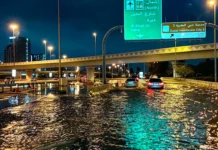 One of India’s spookiest and haunted ruins lies in Bhangarh, Alwar district in the state of Rajasthan. The town of Bhangarh whose haunted status is attracting scores of tourists these days, lies beneath the Sariska forest in Rajasthan. The lost city is open only during the hours of daylight and is strictly prohibited after sunset. The place is beautiful and tranquil. What remains though, is a shadow of a once beautiful kingdom.
One of India’s spookiest and haunted ruins lies in Bhangarh, Alwar district in the state of Rajasthan. The town of Bhangarh whose haunted status is attracting scores of tourists these days, lies beneath the Sariska forest in Rajasthan. The lost city is open only during the hours of daylight and is strictly prohibited after sunset. The place is beautiful and tranquil. What remains though, is a shadow of a once beautiful kingdom.
The Archeological Survey of India doesn’t have an official office here though government regulations state that every historical site must have an office of the ASI. The myth has it that due to the curse of Guru Bala Nath, the whole town was vacated overnight. The Guru Bala Nath forbidden blight devastated the whole town. The tomb of Guru Bala Nath is still found amongst the ruins.
The Bhangarh story
The fortress was established in 1573 by Raja Bhagawant Das, the ruler of the city of Amber. Bhangarh Fort became the residence of Madho Singh, the ruler’s second son who fought alongside his father and brother in many wars. The decline of Bhangarh Fort started in 1630 after Chhatr Singh, son of Madho Singh, got killed in a violent attack. The decline continued until 1783 when the fortress and the city were completely abandoned following that year’s famine.
The myths
It is said that the city of Bhangarh was cursed by the Guru Balu Nath, causing the town’s evacuation. Balu Nath sanctioned the establishment of the town but said: “The moment the shadows of your palaces touch me, the city shall be no more!” Ignorant of such foreboding, one ambitious descendant raised the palace to such a height that it shadowed Balu Nath’s forbidden retreat and thus the town was devastated as prophesied. The small samadhi of Balu Nath is still there.
The other myth is as follows: The charm of princess of Bhangarh Ratnavati was said to be matchless in all of Rajasthan. Being eighteen years old, the princess started getting matrimonial offers from other states. In the same region there lived a Tantrik, a magician well versed in the occult, named Singhia who was desperately in love with the princess despite knowing that he would never be allowed to even see her, let alone meet her. One day, he saw the princess’ maid in the market buying scented oil for her. He used his black magic and put a spell on the oil which would hypnotize the princess by her merely touching the oil, and she would surrender herself. The princess foiled this plan though. She had seen the Tantrik enchanting the oil, and she therefore threw it away, whereupon the flagon rolled over a stone. As soon as the oil touched the stone, it started rolling towards the wicked Tantrik and crushed him. While dying, Singhia cursed the palace with the death of all who dwelt in it, without any rebirth in their destinies. The very next year there was a battle between Bhangarh and Ajabgarh and Ratnavati died.
Garden at Bhangarh premises
Bhangarh is a deserted town with some 10000 dwellings established in 1613 by Madho Singh. Bhangarh fort offers an intact view of the medieval past. Apparently, the Bhangarh town had been desolated by an old Mughal invasion, and is just reverting back to being habited again.
Chhatri on hill top
Bhangarh premises are enclosed by a partially ruined wall. Other than dwellings, ruins of Bhangarh also include gardens, havelis, banyan trees and temples of Lord Someshwar, Gopinath, Mangla Devi and Keshava Rai. But the enigmatic attraction is a secluded chhatri (umbrella) on the hill top which catches attention of travelers. The random placement of all these sites within Bhangarh premises may look frightening and mysterious at the same time.
Ajabgarh Fort near Bhangarh
There are some other forts near Bhangarh built in the same era and sharing related history. Ajabgarh is a picturesque garrison fort between Bhangarh and Pratapgarh, with a lovely reservoir nearby.
Ajabgarh fort was built by Ajab Singh Rajawat, the grandson of Madho Singh and is in good condition. It offers an incredible panoramic view of the eponymous walled town and the Well-preserved, but less visited temple of Shri Raghunath and old chhatris, all nearby.
Pratapgarh is a remarkable fort situated on hill top which dominates the region. Pratapgarh and its vicinity are famous for its natural surrounding and scenic countryside.
Archeological importance
During recent excavations different types of tools used by early man have been recovered from the pre-historical site of Bhangarh. The old town was surrounded on three sides by elevated hills where wild undergrowth is seen today. There were natural springs and waterfalls there and one such is found near the temple of Lord Someshwar. The Archeological Survey of India (ASI) has put up a signboard at Bhangarh stating: “Entering the borders of Bhangarh before sunrise and after sunset is strictly prohibited.” Lot of tourists who visit Bhangarh affirm that there is a strange feeling in its atmosphere which causes symptoms of anxiety and restlessness.
How to reach
Nearby cities of Jaipur and Alwar are great starting points as they are major metropolitan hubs and are easy to get to. Regular bus service leaves for Bhangarh Ruins but it entails about a kilometer of walking because the nearest bus stop is not directly at the ruin. Another option is taxis.






